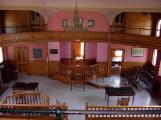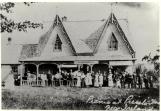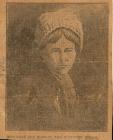1
Tom CollinsThe area of Albert County known as New Ireland is today nothing more than miles and miles of woodlands dotted by the occasional hunting cabin. Very few signs of settlement of the area by the Irish in the early 1800's still exist, except for the Catholic cemetery located next to the spot where the Catholic church once stood, and the names of the roads, hills, and other locations in the area, like Teahans Corner, which offer a hint of the Irish immigrants who settled this land and called it New Ireland. Father McAuley, the Catholic priest for the area, and much of the county, had supervised the construction of the Catholic church and rectory.
2
Saint Agatha's Church in New Ireland built in 1870.19 September 1928
New Ireland, New Brunswick, Canada
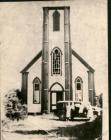
4
It was at this church rectory, in the summer of 1906, that a gruesome murder took place, which would lead to the hanging of a man named Tom Collins.A young Irish man who had grown up in England, named Tom Collins, found his way to Albert County around 1905-1906.
6
He first worked on the docks at Grindstone Island, Gray's Island, and Harvey, where he gained a reputation of being quick tempered, after pulling a knife on another man during an argument. He soon left the docks and went to New Ireland where he was hired by Father McAuley as a handyman. Although he did not know how to chop wood, harness a horse, or do other small jobs a handyman would be expected to do, Tom decided to go and work for the priest, whose cousin, Mary Ann McAuley, took care of the housekeeping at the rectory.8
Father McAuley, as part of his duties, would often travel to other communities in the county where Catholic parishioners lived, to visit them and hold mass. Soon after Collins was hired, the priest left on such a trip, telling Collins to take his orders from Mary Ann in the priest's absence. That Sunday afternoon, Mary Ann sent Tom to a nearby lake to catch some fish. At the lake, Tom met a family who were having a picnic. He then spent most of the afternoon talking with them and, consequently, did not catch many fish. When Tom returned home, Mary Ann scolded him for not catching enough fish for supper, and then sent him to the wood pit to chop wood. Still angry with Tom, she followed him out to the wood pit and continued to nag him.The next morning, Tom was walking east along the main road, towards the village of Albert, carrying two valises (today we call them suitcases), when he met a wagon heading west and hitched a ride. The driver of that wagon later testified that he had seen the priest's horse and carriage outside of the rectory when he had passed the building earlier that morning, while he was heading east towards Albert. Some people believe that Tom had already killed Mary Ann and was planning on escaping with the horse and carriage, but changed his mind and started walking towards Albert when he realized that people would notice him driving the priest's carriage. Collins then got off of that wagon and hitched a ride on another wagon heading back towards Albert. On this trip back towards Albert, Tom asked if the driver had seen the priest's horse and carriage. He said he was supposed to go with Mary Ann to Albert today but that, after he had harnessed the horse, he went to eat breakfast and when he returned, the horse was gone. As they passed the Kent Road, the driver pointed out that there were fresh wagon tracks on the Kent road. Tom asked where the road went and was told that it went north towards Elgin. Tom then jumped off of the wagon and started walking down the Kent road. Tom's next stop was at a house near Elgin to get a drink of water. When asked where he was going, Tom said he was going to Elgin to find Father McAuley to tell him that thieves had broken into the barn and stolen the horse and carriage along with the best horse harness. Father McAuley testified at Tom's murder trial months later that the good horse harness was still in the barn when he arrived home the next day. As to the conflicting stories he had told about what happened to the horse and carriage, Tom would later say that he lied about the horse being stolen to cover up the fact that he was carrying the two valises with him.
When Tom arrived in Elgin, he went to the train station to find out when the next train to Saint John would be leaving. He learned that he had missed that day's train, and that the next train would not arrive until tomorrow. Tom then left the train station, checked into the Garland Hotel in Elgin for the night and ate supper.
9
The Garland Hotel in Elgin was owned and operated by John and Rachel Garland.19 September 1907
Elgin, New Brunswick, Canada

10
When he finished his supper, he went outside and ran into Father McAuley who was walking down the street. Father McAuley had cut short his travels and was returning home early. He asked Tom why he was here. Tom replied that Mary Ann had nagged him about the day he went fishing. Father McAuley asked him if he would return and Tom said that he would go back the next day. So Father McAuley told Tom to come with him, as he knew a place where Tom could stay for the night. However, Collins did not remain there for the night, after Father McAuley left on business, Tom returned to the hotel for his things and began to walk along the railway tracks toward Saint John.The next day, a local man found the missing horse near the Rectory. Knowing that the horse belonged to Father McAuley's he brought the horse back to the rectory. When he arrived he found that the barn door was open, and that the door to the wood house was also open. He went in the wood house but did not see anything in the wood pit. He then called for Mary Ann to come out of the house, but got no answer. The kitchen door to the house was, strangely, open.
Later that same day, Father McAuley returned home without Tom and found the missing horse in the barn. Since Mary Ann was not home when Father McAuley arrived he began to search the rectory for her and noticed that his two valises were missing. Next, he saw that someone had tried to break into his closet with an axe.
11
The closet doors from Father McAuley's bedroom closet at the Rectory in New Ireland.15 September 1903
Hopewell Cape, New Brunswick, Canada
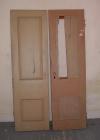
12
Father McAuley unlocked the closet and found the $140, that he kept there for safe keeping, had not been touched. Next, he found that someone had searched through the papers in his office. The man, Jimmy Doyle, who had brought Father McAuley home from Elgin, went to see if Mary Ann was at a neighbour's house and to bring Karen Duffy back to the rectory to get them their supper. It was these two people who would find Mary Ann's body at the bottom of the wood pit in the wood house, her throat slashed from ear to ear with a knife or razor and her head struck near the right ear with a blunt object like an axe. Jimmy Doyle then returned to Elgin to contact the police. Father McAuley and Karen Duffy then searched Mary Ann's room and found that a gold watch, a handkerchief, and several pieces of jewelry, like rings, were all missing. Except for the watch and the jewelry, most of these items would later be found in the valises carried by Tom. The next day, the carriage would be found at the bottom of the field behind the Rectory.Tom during this time, had not tried to escape to Albert to board a ship and head out to sea, as Sheriff Lynds had suspected, but instead had continued to travel towards Saint John. Strangely, he decided to stay near Saint John, working at odd jobs, instead of trying to escape. In his travels to Saint John, several people thought it was odd that Tom carried two watches, one of which was a gold lady's watch which later was identified as matching the description of Mary Ann's missing watch. During his travels Tom told two stories for how he had obtained the watch. One story was that he got it from his sister before leaving England. Later, he said it was for his girlfriend who had died.
The police began to search for Collins. For days they could not find any trace of him, then a break came. They called the house outside of Saint John where Tom was working and gave a description that matched Tom. Tom, who had heard the telephone ring and possibly had over heard the telephone conversation, promptly left, without telling anyone he was leaving. He began walking towards St. George, which is located near the American border. He left in such a hurry that he did not stop to get his valise from the house. His other valise had been dumped in the woods near Elgin.
Tipped off that Tom was heading towards St. George the police arrived there ahead of him and were waiting for him to arrive. However, Tom had taken a different route, which bypassed St. George, and he was now heading towards St. Stephen, which is located on the American border. During this trip, Tom met a man who asked him if he was a sailor. Tom replied that he was, and that he had deserted a ship in Saint John and was heading to St. Stephen to try and find work. The police had learned that Tom was now heading for St. Stephen and they soon caught up to him. They passed him on the road and then waited for him in the bushes a few miles down the road. When he passed by, they jumped out at him but Tom started to run, when they fired a shot over his head Tom decided to give himself up. When the detective asked Collins why he had left his valise at the boarding house, Tom fainted.
The police took Tom to the jail in Saint John. There Tom made a statement to the police. He said that he had got the horse ready to go to Albert that morning, and then had breakfast, but that Mary Ann then said that she did not want to go to Albert because it was too hot. She then started nagging him again about the previous day's fishing, so he left. When asked about the gold watch, Tom first said that he only had a silver watch. Later he said that he had thrown the gold watch away, then he changed his story and said that he had lost it. At the trial Tom claimed that Mary Ann had given him the watch to take to Albert the next day to get it fixed. Although at the trial the question arose why would she give him the watch if she was planning on going to town with him?
The press during this time had been reporting on every detail of the case from the discovery of the body, to the chase from Saint John to St. Stephen, and Collins' eventual capture. Every detail was read by anxious readers all across the province. The press took an immediate liking to the prisoner. Many members of the general public began to speculate that the murder had not been committed by Collins, but by someone who killed Mary Ann during a robbery of the rectory. After all, the rectory had been robbed several months before Tom had arrived. There was even talk that some people in the community did not like Mary Ann. One story even suggested that Father McAuley had killed Mary Ann because she was pregnant with his child, although that was doubtful, since she was 52 years old at the time. The case attracted so much attention that the Premier of the Province, Lemuel Tweedie, acted as Crown prosecutor during the preliminary trial.
Tom Collins would be tried three times for the murder of Mary Ann McAuley. He is thought to be the first man in Canada ever to be tried for the same crime in three separate trials. All three trials would be held at the new court house in Hopewell Cape, constructed only two years earlier.
13
The Court House in Hopewell Cape built in 1904 .15 September 2003
Hopewell Cape, New Brunswick, Canada
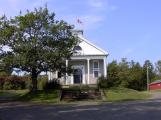
14
The Interior of the Court House in Hopewell Cape.15 September 2003
Hopewell Cape, New Brunswick, Canada
